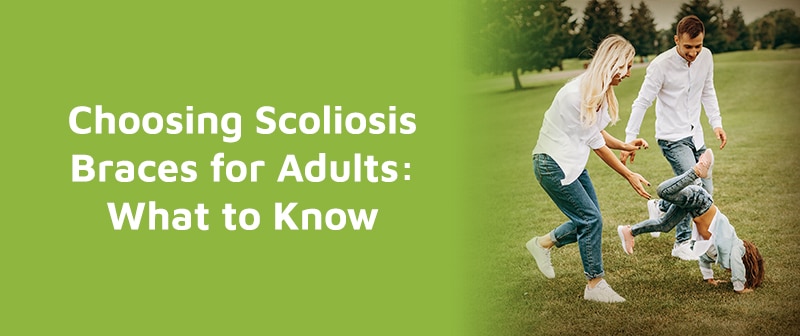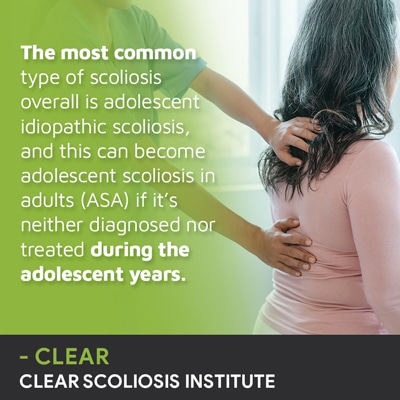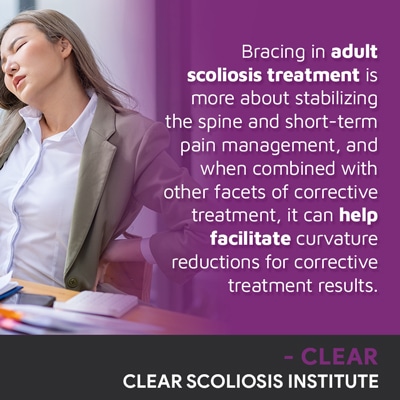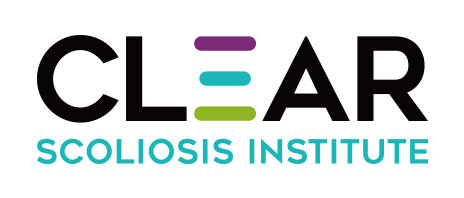
No brace on its own is enough to address scoliosis on all levels, but when combined with other types of corrective treatment, it can help facilitate structural changes within the spine. Corrective bracing can help with pain, curve stability, and when added to a proactive treatment plan can help reduce curve size.
What you need to know about scoliosis bracing is that different types of braces offer different potential results, and bracing for adults has a different focus than bracing in childhood scoliosis. Bracing for adults is more about spinal stability and short-term pain management.
As different types of braces are favored by different treatment approaches, let’s explore the two main treatment approaches.
The two main treatment choices patients have to choose between are traditional surgical treatment and modern conservative treatment.
Here at the CLEAR Scoliosis Institute, patients benefit from a proactive individualized non-surgical approach to addressing scoliosis.
Conservative treatment is proactive and is started immediately following a diagnosis; traditional treatment doesn’t have a strategy for addressing scoliosis while mild so commonly recommends watching and waiting.
A different type of brace is favored by traditional treatment than conservative treatment; these approaches have different treatment goals.
The goal of traditional scoliosis treatment is to stop progression, and the goal of conservative treatment is to correct the scoliosis.
Because traditional treatment doesn’t have an approach for treating mild scoliosi, the watching and waiting can result in patients becoming severe over time and being funneled towards spinal fusion surgery.
All spinal surgeries are risky and invasive, and when we’re talking about adult patients, the older a patient is, the riskier it is, and if spinal fusion fails for any reason, the only recourse is more surgery, and the risks increase with each procedure and increasing age.
So choosing the best scoliosis brace for adults can also mean choosing the best treatment approach.
Let’s also talk about the main types of scoliosis to affect adults.
Scoliosis affects all ages, although it is more often diagnosed in children; the actual rate of scoliosis increases among the aging population.

Idiopathic scoliosis is the most common type to affect adults, and in these cases, it needs to be determined if the scoliosis is going to remain stable or progress, and if an adolescent was unaware they had scoliosis prior to being diagnosed in adulthood, there will be no prior X-rays to compare to.
Adolescent idiopathic scoliosis isn’t commonly painful due to the lengthening motion of growth the spine is going through; this counteracts compression-related pain, and when mild, the symptoms are also mild and can be difficult to detect.
As an adolescent grows, their scoliosis can be progressing, and when skeletal maturity is reached, it’s quite common for patients to start experiencing pain that leads to assessment and diagnosis.
Compressive scoliosis pain can involve the muscles, the back, and pain radiating into the extremities due to nerve compression.
It’s pain that brings most adults in for assessment and diagnosis, and for children, the main symptoms of scoliosis that lead to being diagnosed are postural changes like uneven shoulders and hips.
The next most common type to affect adults is degenerative scoliosis, and this involves older adults (45+) and is caused by natural age-related degenerative changes in the spine; these changes usually involve the spinal joints breaking down and/or disc issues.
Females are more affected by degenerative scoliosis, and this is thought to be the result of menopausal changes (bone density and hormones).
Most cases of degenerative scoliosis will be progressive because the spine is unstable and unbalanced, and without treatment, will get worse over time, putting older adults at risk for falls.
After a certain age, a simple fall can be catastrophic, so a goal of degenerative scoliosis treatment is to increase spinal stability and support to improve movement and balance.
So now that we’ve touched on the different types of adult scoliosis, let’s talk about bracing in adult scoliosis treatment.
When it comes to adult scoliosis bracing, the focus is different than childhood scoliosis bracing, and this is because adult scoliosis is progressing at a different rate and pain management is often a focus of adult scoliosis treatment.
Progression is triggered by growth, so children are the most at risk for continued progression, and adolescents are the most at risk for rapid progression due to puberty and its unpredictable growth spurts.
So in childhood scoliosis treatment, a focus is on achieving a significant curvature reduction and holding results despite the constant trigger of growth occurring, and bracing is a regular facet of childhood scoliosis treatment because growing spines are more malleable and responsive to bracing.
In adult scoliosis treatment, the process can be less intense as the pressure of rapid progression isn’t there, but what is there is the ever-present threat of increasing spinal degeneration.

Depending on what treatment approach an adult has chosen, they will likely be funneled in the direction of a particular type of scoliosis brace.
Those undergoing traditional treatment will likely be recommended the boston brace which is the most commonly used orthotic in this approach.
The boston, however, is associated with a number of shortcomings; it doesn’t address scoliosis as a 3-dimensional condition, ignoring its rotational component.
The boston was also designed in the 1970s, but its design has changed little over the years, and a brace that’s cumbersome and difficult to conceal and wear under clothes is one that will have compliance issues.
Compliance is the main challenge to bracing success. In addition, the boston brace squeezes the brace excessively to hold it in a straighter alignment, but the squeezing pressure can weaken the spine over time.
Let’s talk about a modern brace option that addresses the boston’s shortcomings.
The ultra-corrective ScoliBrace has the goal of correcting scoliosis, not just stopping it from getting worse.
The ScoliBrace has the goal of 3-dimensional correction so addresses the spine’s rotation as well as its unnatural bend.
The ScoliBrace® also pushes the spine into a better position, rather than squeezing it excessively.
The ScoliBrace is also fully customized using state of the art scanning technology to ensure each brace is as comfortable as possible for the patient.
And most importantly, the ScoliBrace® is a facet of a proactive conservative treatment approach that combines the power of multiple scoliosis treatment disciplines.
Conservative treatment integrates chiropractic care, physical therapy, scoliosis exercises, a number of thera[ies, and rehabilitation so conditions can be impacted on every level for true corrective results.
What to know about adult scoliosis bracing is that no brace on its own can correct scoliosis, but a corrective brace does have the potential to augment corrective treatment results by pushing the spine into a straighter alignment.
It’s also important to understand the two main scoliosis treatment approaches so the appropriate treatment decision can be made; the way a diagnosis is responded to with treatment can shape how the spine functions in the future.
Those who commit to traditional scoliosis treatment commonly find themselves watching and waiting, and if bracing is applied, it’s a traditional brace like the boston that’s known for its outdated design and poor rate of compliance.
The design of the modern corrective ScoliBrace® addresses the shortcomings of traditional bracing and represents what we've learned over the years about scoliosis and bracing efficacy.
The ScoliBrace® also doesn’t work alone because it’s part of a proactive and integratie treatment response; it works with a number of chiropractic techniques and manual adjustments, physical therapy, scoliosis exercises, and rehabilitation.
As a CLEAR-certified scoliosis chiropractor, I want my adult patients to know that it’s never too late to start treatment, and in many cases, surgical intervention isn’t necessary, particularly with a proactive treatment approach that includes corrective bracing.

CLEAR provides a unique and innovative way of understanding scoliosis. Sign up to receive facts and information you won’t find anywhere else.
